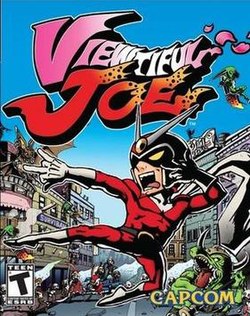Viewtiful Joe
| Viewtiful Joe | |
|---|---|
 |
|
| Developer(s) | Capcom Production Studio 4 |
| Publisher(s) | Capcom |
| Director(s) | Hideki Kamiya |
| Producer(s) | Atsushi Inaba |
| Programmer(s) | Noriyuki Ōtani |
| Artist(s) | Kumiko Suekane |
| Composer(s) | Masakazu Sugimori Masami Ueda |
| Platform(s) | GameCube, PlayStation 2 |
| Release date(s) |
GameCube PlayStation 2
|
| Genre(s) | Action, platform, beat 'em up |
| Mode(s) | Single-player |
| Aggregate scores | |
|---|---|
| Aggregator | Score |
| GameRankings | 92% (74 reviews) (GCN) 88% (39 reviews) (PS2) |
| Metacritic | 93 of 100 (52 reviews) (GCN) 90 of 100 (43 reviews) (PS2) |
| Review scores | |
| Publication | Score |
| EGM | 8.7 of 10 (GCN) 8.7 of 10 (PS2) |
| Eurogamer | 9 of 10 (GCN) 9 of 10 (PS2) |
| Famitsu | 33 out of 40 (GCN) |
| GamePro | 5 of 5 (GCN) 4.5 of 5 (PS2) |
| GameSpot | 9.2 of 10 (GCN) 8.8 of 10 (PS2) |
| GameSpy | 5 of 5 (GCN) 5 of 5 (PS2) |
| IGN | 9.5 of 10 (GCN) 9.1 of 10 (PS2) |
| Play | 100% (GCN) 91% (PS2) |
Viewtiful Joe (ビューティフル ジョー Byūtifuru Jō?) is a side scrolling beat 'em up video game developed by Team Viewtiful for the GameCube. It was originally released in 2003 as a part of the Capcom Five under director Hideki Kamiya and producer Atsushi Inaba. The game was later ported to the PlayStation 2 by the same design team under the name Clover Studio, subtitled Aratanaru Kibō (新たなる希望?, lit. "A New Hope") in Japan. The game's story concerns Joe, an avid movie-goer whose girlfriend Silvia is kidnapped during a film starring Joe's favorite superhero, Captain Blue. Joe is shortly thereafter thrust into Movieland, where Silvia is taken by the villainous group known as Jadow. After accepting a special V-Watch from Captain Blue, Joe transforms into the tokusatsu-style persona "Viewtiful Joe" and sets out to rescue her.
The gameplay of Viewtiful Joe features traditional 2D platform side-scrolling intermixed with 3D cel-shaded graphics. Abilities known as "VFX Powers" grant the player special actions for combat and puzzle-solving, such as slowing down or speeding up time. Viewtiful Joe was critically acclaimed for its unique visual style and gameplay, earning itself a number of awards from various media publications. A minor commercial success, the game spawned a few sequels with releases seen on other consoles such as the PlayStation Portable (PSP) and Nintendo DS. An anime adaption of the game was also produced.
...
Wikipedia
